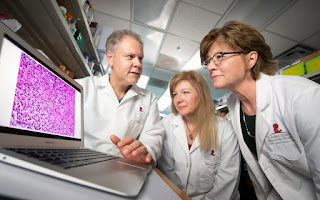Research reveals machinery of a deadly childhood brain cancer
Authors (from left) Jon Larson, PhD, Lawryn Kasper, PhD, and suzanne Baker, PhD, revealed how the H3 K27M mutation impacts the development of DIPG. The laboratory models the group produced will be important for future studies of DIPG.
Credit: St. Jude Children's Research Hospital.
St. Jude Children's Research Hospital scientists have mapped the effects of aberrant biological machinery that drives a deadly brain cancer called diffuse intrinsic pontine glioma (DIPG). The research included development of a genetically engineered mouse that will offer ways to further understanding of such brain cancers, as a laboratory model for developing more effective treatments.
The findings appear online today in the journal Cancer Cell. Suzanner Baker, Ph.D., of the St. Jude Deparment of Developmental Neurobiology and director of the Brain Tumor Research Division, was the senior author.
DIPGs are incurable brainstem tumors that strike hundreds of children a year in the U.S. Current treatments of radiation and chemotherapy are largely
ineffective, and fewer than 10 percent of children with the tumors survive more that two years.
Although many cancers arise from mutations in the genes that directly drive abnormal cell proliferatioon or survival, others such as DIPGs arise from abnormalities in the cell's ''epigenetic'' machinery for managing gene activin, or expressin.




Comments
Post a Comment